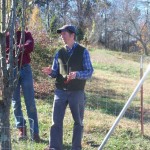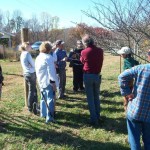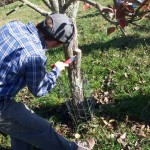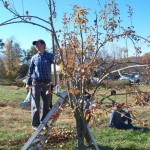It starts with the clang and rattle of a lid being removed from the feed barrel. A deep belch like rumble, like that of an uncouth relative rolls from the woods, answered by other noises, all gastric in tone. The hogs have awakened. From various locations in the woods, for they all seem to have their own special sleeping spaces, the sounds grow in volume and slowly converge near the gate. I’m still a couple of hundred yards away and unseen. But they know I’m there and impatiently wait until I round the corner swinging a five gallon bucket of feed in one hand.
The feed bucket contains the contents of 10 cans of food purloined from the picked over debris of Donald’s belongings. After we bought his old house we spent a day hauling the bits and clutter from his life to the dump. But the canned food, a few hundred cans worth, well that was worth saving. So each day for the past month I open and heat about ten cans of creamed corn, sauerkraut, carrots, black beans, northern beans, mustard greens, spinach, sweet potatoes, add about five pounds of shelled and cracked corn and slop into the trough, turning deep belches of hunger into grunts of contentment.
Simon Fairlie in his essential work Meat: a benign extravagance
has an interesting chapter titled “The plight of the pig in the nanny state” dealing with food waste due to excessive interference by an over protective bureaucracy. He touches on how a complex system of food waste collection from homes and businesses in Germany and Austria fed six million hogs a year. That is until forced to stop this practice by the E.U. in 2006 and move their production to commodity grains. The ostensible reason was the danger of feeding tainted swill to hogs that could pass on pathogens to humans. The reality was that their system produced statistically zero cases. Provided one follows basic food safety controls feeding slops to hogs is safe, useful and makes sense and has fed pigs for tens of thousands of years.
Instead the E.U. has moved to an expensive system of feeding an omnivore exclusively on grains: grains that could be used to feed people. Hogs have always been the companions of humans living off their excess waste. The timidity of the E.U. certainly had no impact on the third world. Predictably hog production in Europe has declined even as pork consumption has remained steady. China and other countries with less strict controls and perhaps scruples over food safety have filled that void. Shipping pork at a lower price for thousands of miles in container ships to a consumer that had a perfectly sound system of low cost production at hand…now, that makes perfect sense!
In a world of population overshoot, waste of food products seems senseless. Yet every day one hears or reads about the struggle of landfills in the modern world to deal with food waste. Some ingenious people come up with overly complex methods to turn it into compost, methane farms, etc. with high tech and high energy inputs. But the simple low cost method of feeding pigs that feed us is abandoned, except by the small farmer, in favor of subsidized grain production.
The age old “A pig is health” or “a pig pays the rent” are simple testaments to the enduring relationship between hogs and food security for thousands of years of human history. Sometimes a wheel does not need to be reinvented.
Speaking of wheels, the sun is starting to rise and soon our “uncouth relative” will be demanding attention out in the woods.




